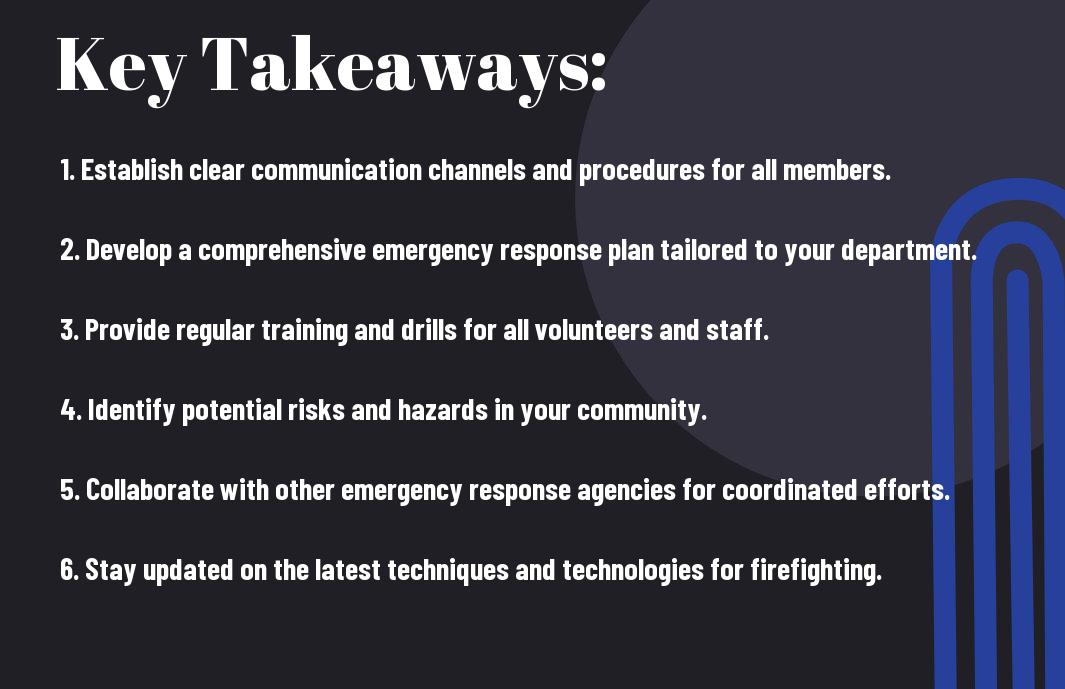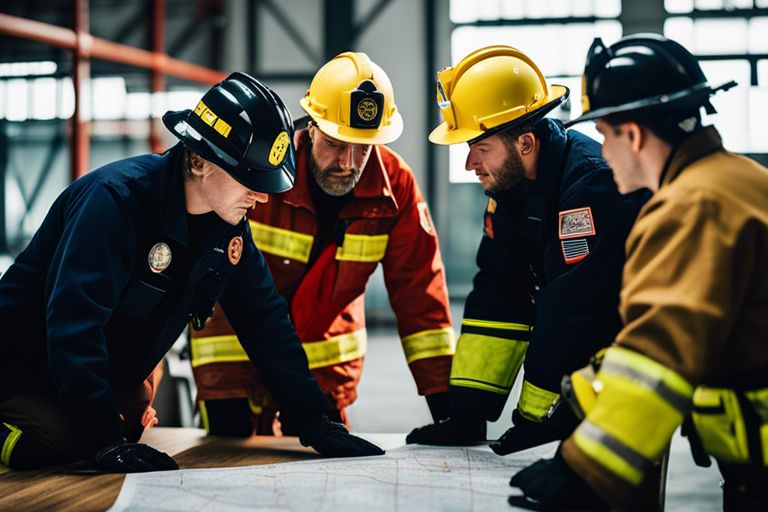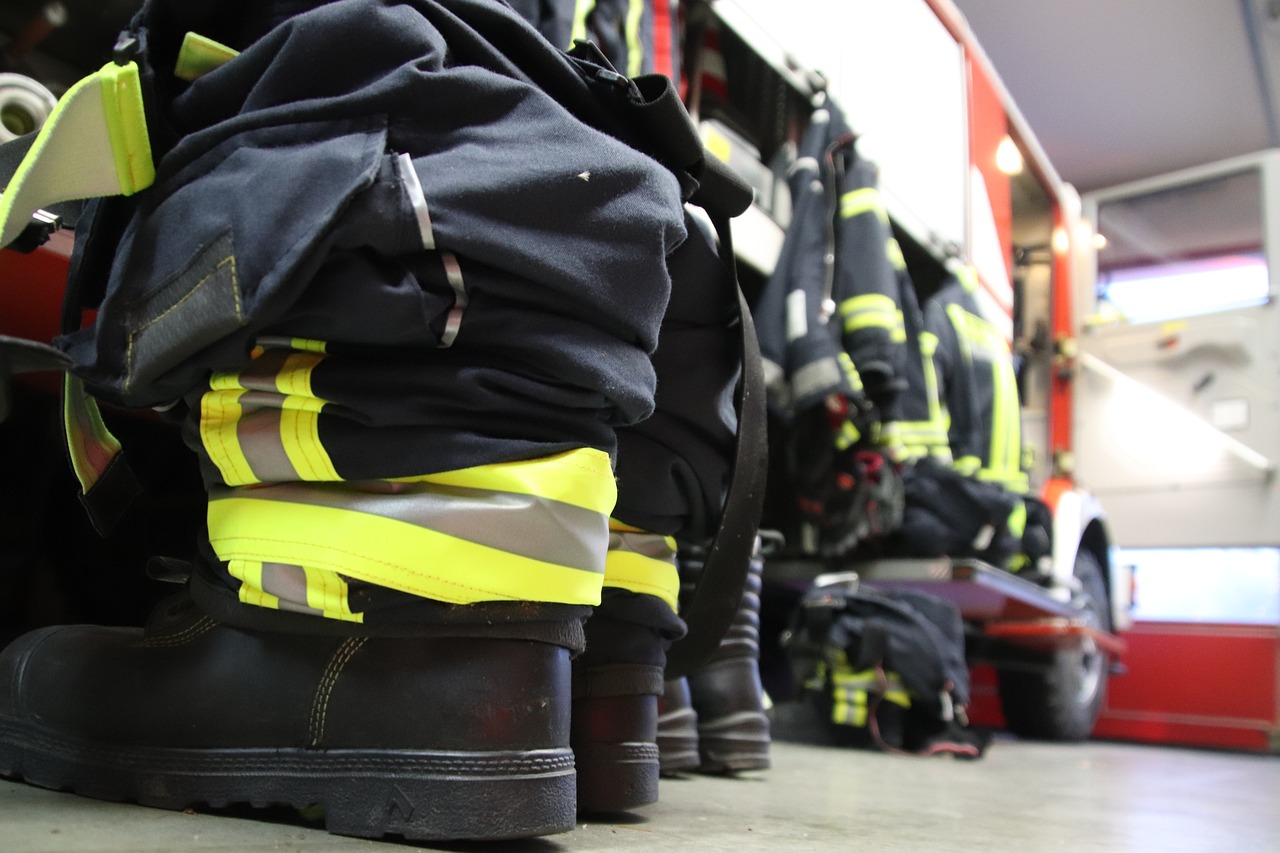Most crucial in maintaining efficient emergency response in volunteer fire departments is strategic planning. Your team’s ability to swiftly and effectively handle emergencies relies on detailed preparation. By following these imperative steps, you can ensure effective coordination, communication, and response when seconds count.
Identifying Risks and Hazards
Assessing Community Risks
One of the vital steps in emergency response planning for volunteer fire departments is assessing the risks present in your community. When you understand the specific hazards that your community faces, you can better prepare for potential emergencies. Begin by collaborating with local government agencies, community leaders, and residents to gather information on the most common threats, such as natural disasters, industrial accidents, or transportation incidents.
Identifying Potential Hazards
Identifying potential hazards within your fire department’s jurisdiction is crucial for effective emergency response planning. Evaluate your response area to pinpoint specific risks, including high-risk facilities, hazardous materials storage, or areas prone to wildfires. Create detailed maps that outline these hazards, and ensure that all firefighters are familiar with the potential risks they may encounter during emergency responses.
By identifying hazards in advance, you can develop targeted training programs, establish response protocols, and acquire necessary equipment to address each risk effectively. Understanding the hazards in your community empowers your volunteer fire department to be proactive in preparing for emergencies and keeping your responders and community safe.
Establishing Emergency Response Protocols
If your volunteer fire department wants to ensure a coordinated and effective response to emergencies, it is crucial to establish emergency response protocols. These protocols provide a framework for how your team will operate during various types of incidents and help ensure that everyone knows their role and responsibilities.
Developing Standard Operating Procedures (SOPs)
With the development of Standard Operating Procedures (SOPs), your department can establish a set of guidelines that outline how different emergency situations should be handled. SOPs provide a **clear** roadmap for your team to follow, ensuring that everyone is on the same page when responding to incidents. It is imperative to regularly review and update these procedures to reflect changes in equipment, personnel, or best practices.
Designating Roles and Responsibilities
On top of having SOPs in place, it is crucial to designate specific roles and responsibilities to **each** member of your team. By clearly defining who is responsible for what during an emergency, you can **ensure** a more coordinated and efficient response. Roles such as incident commander, safety officer, and communications officer should be assigned based on **individuals’** skills and training. **This** allows for better coordination and **allocation** of resources during emergencies.
Communication and Coordination
Even in the most organized volunteer fire department, effective communication and coordination are important in emergency response planning. To ensure seamless operations during emergencies, it is crucial to establish clear communication channels within your department. The Fire Department Pipeline Response, Emergency Planning, and Preparedness (FD PREPP) Toolkit provides valuable resources to assist you in developing robust communication strategies.
Establishing Communication Channels
Coordination among all members of the volunteer fire department is necessary to guarantee that information flows efficiently during critical situations. Regular drills and training exercises focusing on communication protocols can help familiarize everyone with their roles and responsibilities. Designating a communication officer responsible for liaising with emergency services can enhance inter-departmental coordination.
Coordinating with Other Emergency Services
On rare occasions, emergencies may require collaboration with other emergency services like law enforcement or medical responders. Communicating effectively with these entities is crucial to ensure a coordinated response. Building relationships and establishing protocols for joint operations can lead to a more efficient and effective emergency response. Bear in mind, in emergencies, every second counts, so seamless coordination with other services is paramount.
Training and Drills
All volunteer fire departments must prioritize training and drills to ensure readiness for any emergency situation. Training sessions and drills are vital to keep your team prepared and knowledgeable in handling various scenarios effectively.
Conducting Regular Training Sessions
It is crucial to conduct regular training sessions to enhance your skills and knowledge. These sessions should cover various topics such as fire suppression techniques, search and rescue operations, medical emergencies, and communication protocols. By consistently honing your abilities, you will be better equipped to handle emergencies with confidence and expertise.
Scheduling Drills and Exercises
The scheduling of drills and exercises is vital to test your team’s response time and effectiveness in simulated emergency situations. Make sure to plan drills that mimic real-life scenarios to challenge your skills and coordination. Regular drills not only help identify areas for improvement but also foster teamwork and cohesion among your team members.
The frequency of drills should be consistent to maintain preparedness and ensure that all members are well-versed in emergency procedures. Consider incorporating different scenarios and challenges to enhance your team’s adaptability and problem-solving skills during emergencies.
Resource Management
To ensure efficient emergency response in your volunteer fire department, it’s crucial to effectively manage your resources. This includes inventorying equipment and supplies as well as budgeting for emergency response.
Inventorying Equipment and Supplies
An imperative step in resource management is inventorying all equipment and supplies available to your volunteer fire department. Regularly auditing your inventory can help you identify any missing or expired items that need to be replaced. By keeping a detailed record of your resources, you can ensure that you are well-prepared for any emergency situation that may arise.
Budgeting for Emergency Response
With respect to budgeting for emergency response, it’s important to allocate your funds wisely. Consider the potential costs of training, equipment maintenance, and emergency supplies. By creating a detailed budget that accounts for all necessary expenses, you can ensure that your volunteer fire department is financially prepared to handle any situation that comes your way.
Effective budgeting for emergency response will help you prioritize your spending and allocate resources where they are most needed. By carefully planning and managing your budget, you can make sure that your volunteer fire department is well-equipped to respond to emergencies without overspending or running out of imperative supplies.
Incident Command and Control
After an emergency situation arises, it is crucial for your volunteer fire department to have a well-established incident command and control system in place. This ensures that all emergency response actions are coordinated effectively and efficiently. As part of your preparedness efforts, you can refer to resources such as Emergency Preparedness and Response: Getting Started to help you set up the necessary structures.
Establishing Incident Command Structure
For proper incident management, it is vital to establish a clear incident command structure within your volunteer fire department. This structure outlines the roles and responsibilities of each individual involved in the response efforts. Assigning positions such as Incident Commander, Operations Chief, Safety Officer, and Public Information Officer ensures that there is a defined chain of command and effective communication channels during an emergency.
Managing Incident Resources
The effective management of incident resources is critical in ensuring a successful emergency response. The Incident Commander is responsible for assessing the situation swiftly and allocating resources such as personnel, equipment, and facilities efficiently. By prioritizing the deployment of resources based on the severity of the incident, timely and effective assistance can be provided to those in need.
Understanding how to effectively manage incident resources can make a significant difference in the outcome of an emergency situation. Proper utilization of resources, including coordinating mutual aid from neighboring departments, can help enhance the overall response effectiveness and improve the safety of both responders and the community at risk.
Review and Revision
Once again, it’s important to emphasize the significance of reviewing and revising your emergency response plans. This step is crucial to ensure that your volunteer fire department is continuously improving and staying prepared for any situation that may arise.
Debriefing and Reviewing Response Efforts
With each emergency response, conducting a thorough debriefing session is imperative. Gather your team to reflect on the response efforts, discuss what went well, identify areas for improvement, and address any challenges faced during the incident. By reviewing each response in detail, you can learn from past experiences and enhance your department’s future performance.
Revising Protocols and Procedures
To keep your emergency response plans up to date and effective, you must regularly revise your protocols and procedures. Review your existing protocols to identify any weaknesses or outdated practices that need to be addressed. Update them with any new information, technologies, or best practices that can help optimize your department’s response capabilities.
This step is crucial to ensure that your team is using the most effective and efficient methods in emergency situations. By continuously revising your protocols and procedures, you can enhance the overall performance and readiness of your volunteer fire department.

Summing up
So, as a volunteer firefighter, it is crucial to follow vital steps for emergency response planning to ensure the safety and efficiency of your department. By conducting thorough risk assessments, creating detailed emergency response plans, providing regular training, and establishing strong communication channels, you can better prepare your team to handle any situation that may arise. Recall, being proactive in planning for emergencies can make all the difference in effectively responding to them.



